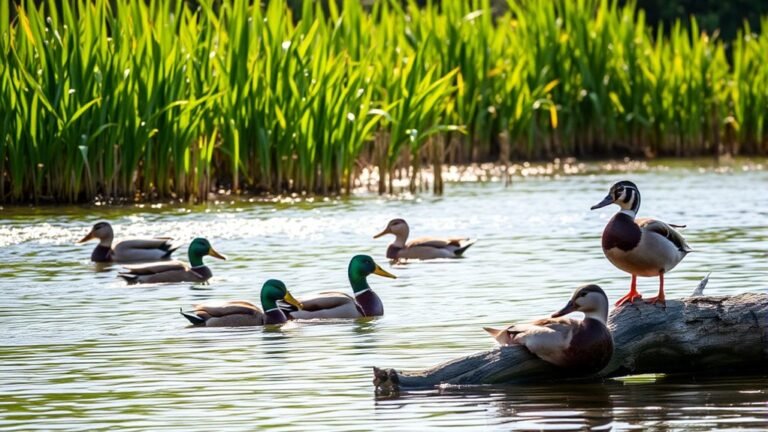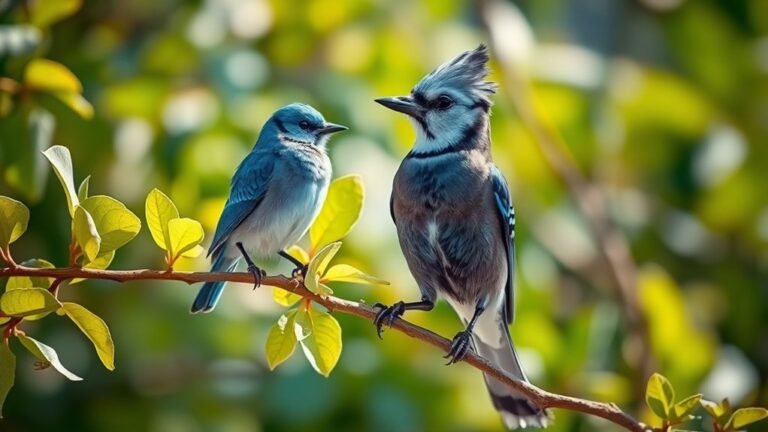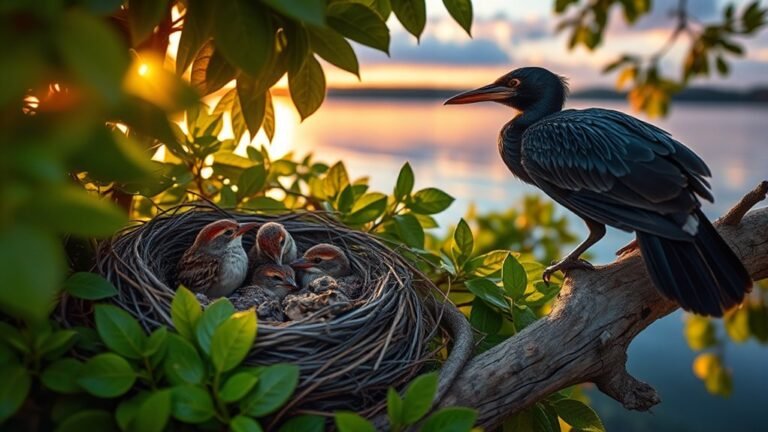Birds With Orange Chests: Identification Tips
When you're out birdwatching, look for birds with orange chests. This can make your experience fun and exciting! Start by checking their size and shape. For example, the American Robin is round, while the Rose-breasted Grosbeak has a sturdier body.
Next, pay attention to their colors. Even small changes in color can help you tell them apart. Also, in spring, you might see brighter colors during the breeding season.
Listening to their calls can also help you identify them. Each bird has its own unique sound.
What else can help you recognize these beautiful birds? Let's explore!
A Quick Overview
Here are some tips to identify birds with orange chests.
First, look at the size and shape of the birds. Small birds like the American Robin are easy to spot, while larger ones like the Rose-breasted Grosbeak are different.
Next, pay attention to their colors. The brightness and patterns can tell you which bird it is. Colors can also change with the seasons.
Listen closely to their sounds. The American Robin sings cheerful songs, while other birds might make sharper noises.
Check where you see these birds. American Robins like gardens and parks, but Eastern Towhees prefer thick bushes.
Lastly, watch how their colors change with the seasons. You will notice their bright orange in spring and duller shades in winter. This can help you know when they are around.
With these tips, you can spot and enjoy watching orange-chested birds!
Understanding Bird Habitats

If you want to spot birds with orange chests, knowing where they live can really help. Different birds like different places.
For example, the American Robin loves open woods and gardens in neighborhoods. The Eastern Towhee, on the other hand, likes to hang out in thick bushes.
During spring, when many birds move around, you might find orange-chested birds near wetlands where food is easy to find. Learning about where they nest and where they look for food can make it easier to see them.
Talking with other birdwatchers can also make birdwatching more fun. You can share tips and stories about these colorful birds and their homes.
Happy birdwatching!
Identifying Size and Shape

Size and shape are important clues to help you identify birds with orange chests. Let's start with size. Small birds, like the American Robin, are thick and round, while larger birds, like the Rose-breasted Grosbeak, have a sturdier build.
Next, look at their wings. Broader wings often mean the bird can soar high in the sky, while shorter wings help them fly quickly and with more turns.
Pay attention to the shape of their bodies, too. Some birds have long bodies and tails that help them be quick and agile. Other birds are more compact and sturdy.
The shape of their tails also gives hints about how they fly. For example, forked tails can mean different flying patterns.
Observing Color Patterns

After looking at the size and shape of orange-chested birds, the next step is to check their color patterns. Observing these details helps us identify the birds and understand how they behave and where they live.
Here are some things to focus on:
- Pattern Distribution: Look at how the orange color mixes with other feather colors. This can show if a bird is marking its territory or trying to attract a mate.
- Intensity and Shade: Some orange colors are brighter or darker. These differences can help us tell one bird species from another and show how they adapt to their surroundings.
- Seasonal Changes: Some birds change colors with the seasons. This can relate to breeding times or changes in the environment.
Listening to Bird Calls
When you watch birds with orange chests, listening to their calls is just as important as seeing their colors and patterns. Being able to recognize their sounds helps you tell them apart. Each bird makes its own special sounds, with different pitches and rhythms.
For example, the American Robin sings cheerful, sweet tunes, while the European Stonechat makes quick, sharp notes.
It can help a lot to record their calls and listen to them later. You can even use sound identification apps to match calls while you're outside. Paying attention to their sounds helps you connect with other bird watchers and makes your birdwatching adventures more fun.
Recognizing Behavioral Traits
Watching birds with orange chests can help you learn how to identify them better. Here are some simple behaviors to look out for:
- Courtship Displays: Look for these birds puffing out their chests and fluttering their wings. This is part of their mating dance, especially during breeding season. Each kind of bird has its own way of showing off.
- Social Interactions: Pay attention to how these birds talk to each other. They use sounds and body movements, like preening or sharing food, to communicate.
- Feeding Habits: Notice how they find food. Some birds pick insects from leaves, while others search for food on the ground. These habits can give you helpful hints about which birds you're seeing.
Noting Seasonal Changes
As the seasons change, you'll see different behaviors and looks in birds with orange chests. In spring and summer, their colors are bright, and they sing a lot because it's their breeding time.
In autumn, you can watch them migrate south or gather in groups. Look for birds like the American Robin and the Eastern Bluebird during this time.
In winter, their colors are less bright, and you may see fewer of them. Noticing these changes helps you connect more with local birds and appreciate nature better.
Sharing what you see with other bird lovers makes it even more fun!
Exploring Geographic Distribution
Many bird lovers enjoy learning about where birds with orange chests live. It makes birdwatching more fun. Here are three simple things to think about:
- Migration Patterns: Birds like the American Robin move from one place to another during different seasons. This means you might see them in some areas at certain times of the year.
- Habitat Preferences: Birds with orange chests like to live in certain places. They often choose open woods, parks in cities, and wetlands. Knowing these spots helps you find them more easily.
- Regional Variability: Different areas have different birds. Learning about the birds in your local area can help you enjoy birdwatching with friends and neighbors.
Learning About Nesting Preferences
Birds with orange chests are fun to watch! Knowing where they like to nest can help you see them better. These birds often choose cozy spots like thick bushes, tall trees, or even old logs.
When you look for their nests, pay attention to what they use to build them. You might see them using grasses, feathers, twigs, and even bits of animal fur.
Different birds have their own favorite nesting spots. For example, the American Robin likes grassy places near trees. On the other hand, the Eastern Towhee often makes its nest right on the ground.
By learning about these birds and their habits, you can feel more connected to nature. So grab your binoculars, get outside, and enjoy watching these beautiful creatures!
Happy birdwatching!
Utilizing Field Guides and Apps
Finding birds with orange chests is fun and exciting! Having the right tools makes it even better. Using field guides and apps helps you spot and identify birds easily.
Here are three helpful resources to try:
- Field Guides: Get a good field guide with clear pictures and descriptions. Look for details about size, where they live, and the sounds they make.
- Mobile Apps: Use birding apps that show you where birds are and give information about their habitats. These apps help you identify birds right away and show migration patterns.
- Community Forums: Join online groups where bird watchers share their findings, tips, and photos. This way, you can learn more and feel part of a bird-loving community.
With these tools, you'll get better at spotting birds and enjoy watching them even more!
Keeping a Birdwatching Journal
Keeping a birdwatching journal is a great way to record what you see and improve your skills. To make your journal clear and easy to use, you can organize it by date, location, or type of bird.
When you write, use bullet points for quick notes. For special sightings, write longer descriptions. Include details about the bird's colors, what it does, and where you see it. This helps you identify the birds better later on.
If you can, add sketches or photos to your entries—these make your records even more fun!
As you look back at your notes, you might notice patterns. You'll learn more about orange-chested birds and how they behave. Keeping this journal sharpens your observation skills and connects you with other bird lovers. Enjoy your birdwatching!
Frequently Asked Questions
What Are the Best Times for Spotting Orange-Chested Birds?
If you want to see orange-chested birds, the best times are early in the morning and late in the afternoon. These birds are often more active during these hours.
You can see them best during migration seasons. In autumn, their bright colors stand out against the colorful leaves. In spring, they are easy to spot among the flowers.
Do Orange-Chested Birds Prefer Specific Types of Food?
Orange-chested birds like to eat different types of food. They often choose insects, fruits, or nectar based on what they like best. Watching how they search for food can help you learn more about their role in nature. This can make your birdwatching more fun and interesting!
Can Orange-Chested Birds Migrate Long Distances?
Yes, orange-chested birds can migrate long distances. Their journeys often depend on the places where they like to live and find food. These birds move to different areas when the seasons change to find the right environment for feeding and breeding. You might see them flying far away because they need certain habitats at different times of the year. Watching these birds chase the seasons can be quite exciting!
Which Regions Have the Highest Diversity of Orange-Chested Birds?
Central and South America are home to many colorful birds with orange chests. These areas have rainforests and bushes that make perfect places for these birds to live. Some of the orange-chested birds you can find there include the Eastern Towhee and the American Robin. These beautiful birds enjoy their habitats and add color to the regions. It's a great chance for birdwatchers to see these species in their natural setting!
Are There Any Conservation Efforts for Orange-Chested Bird Species?
Yes, there are conservation efforts for orange-chested bird species. These efforts focus on keeping their homes safe and creating breeding programs. When you support these programs, you help these birds survive. This also helps nature stay healthy and brings people together who care about birds.

Luna is the passionate founder and author of Birds and You, a website dedicated to sharing her love for birds with fellow enthusiasts. Through her engaging articles and guides, she aims to educate and inspire others to explore the fascinating world of birds. When she’s not writing, you can find Luna observing birds in their natural habitats or sharing beautiful bird photography on Pinterest. Join her on this journey to celebrate and protect our feathered friends!







